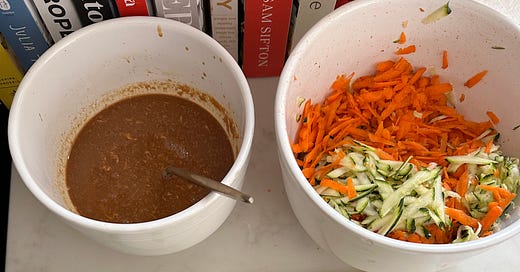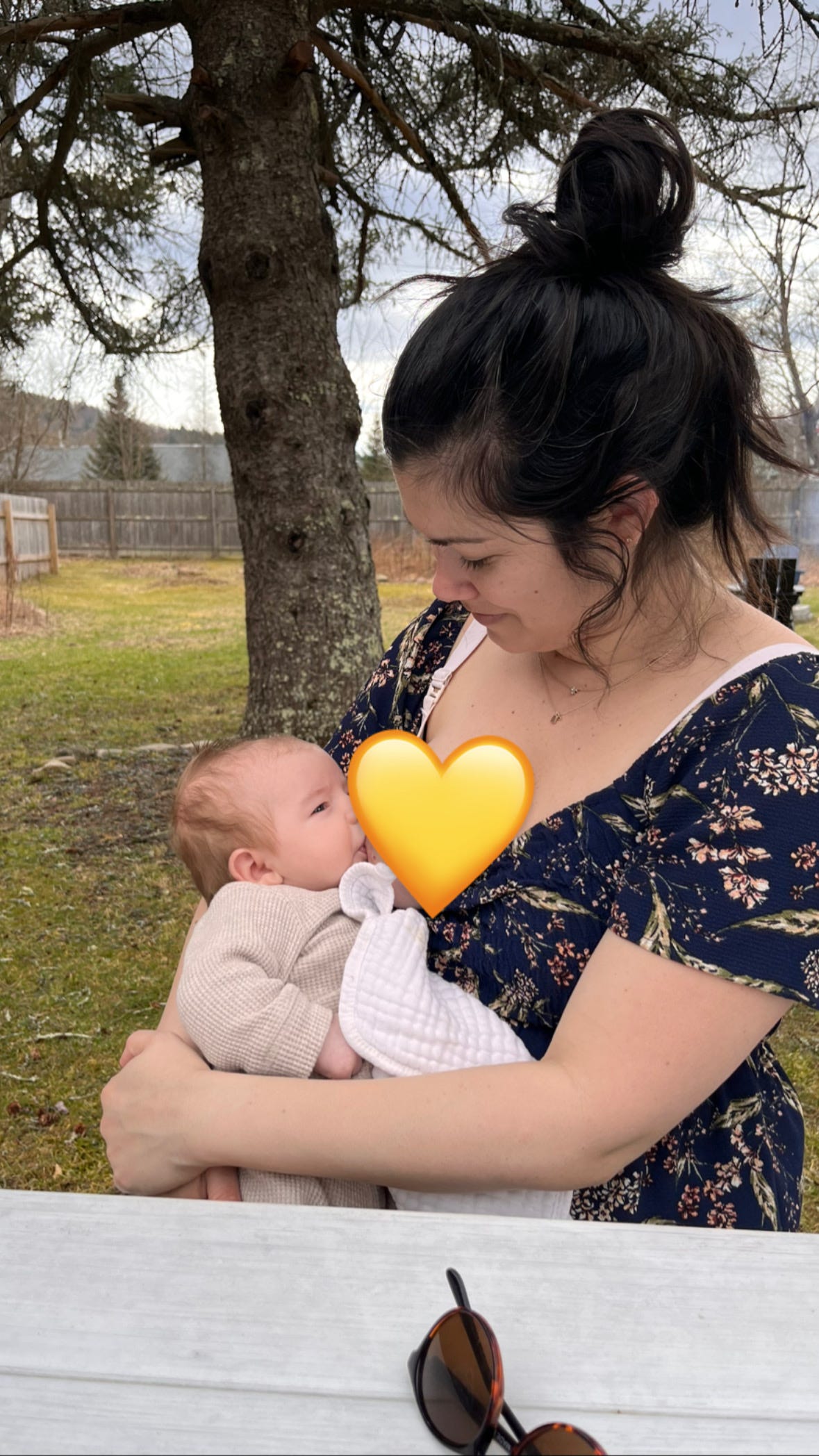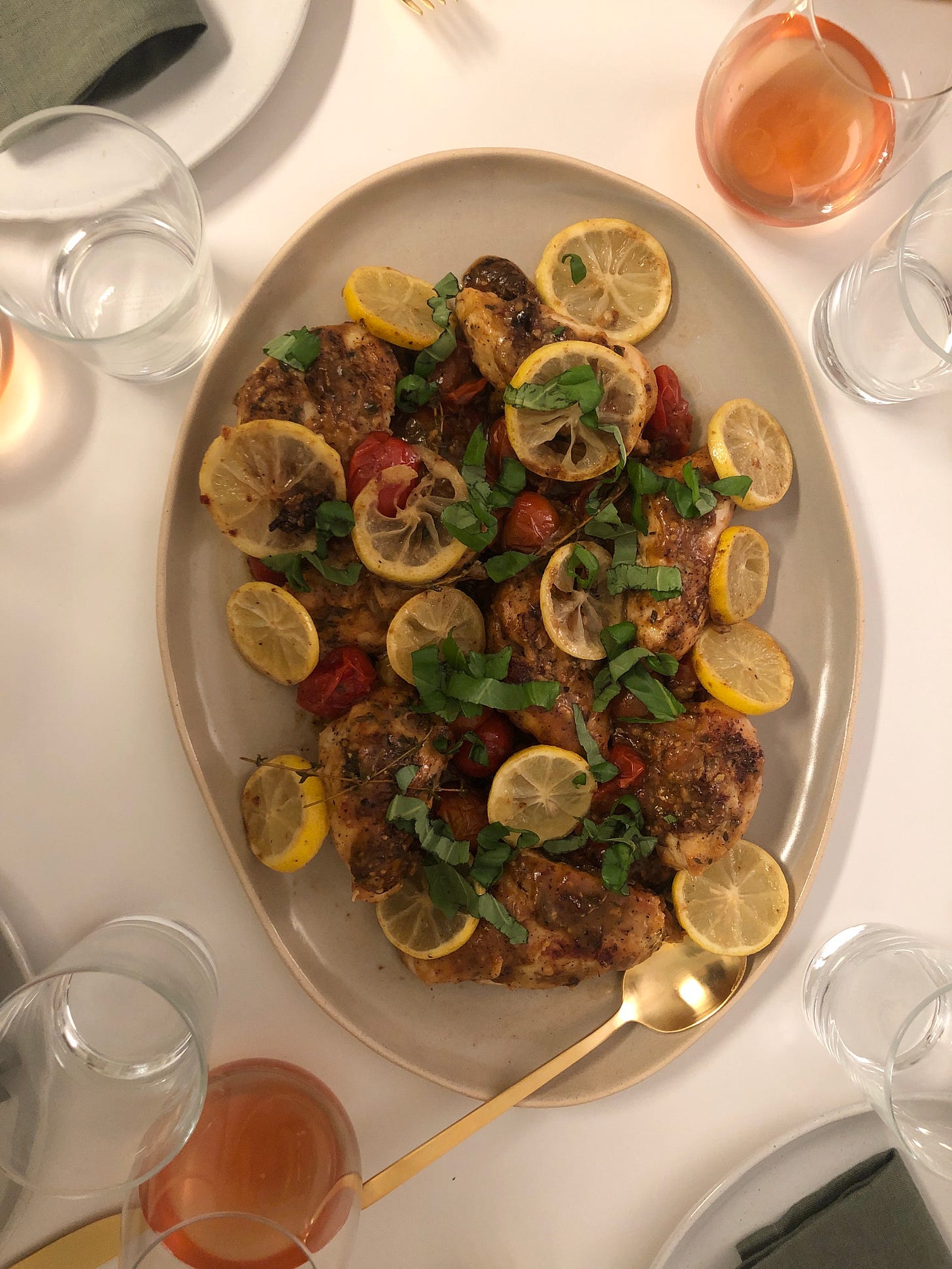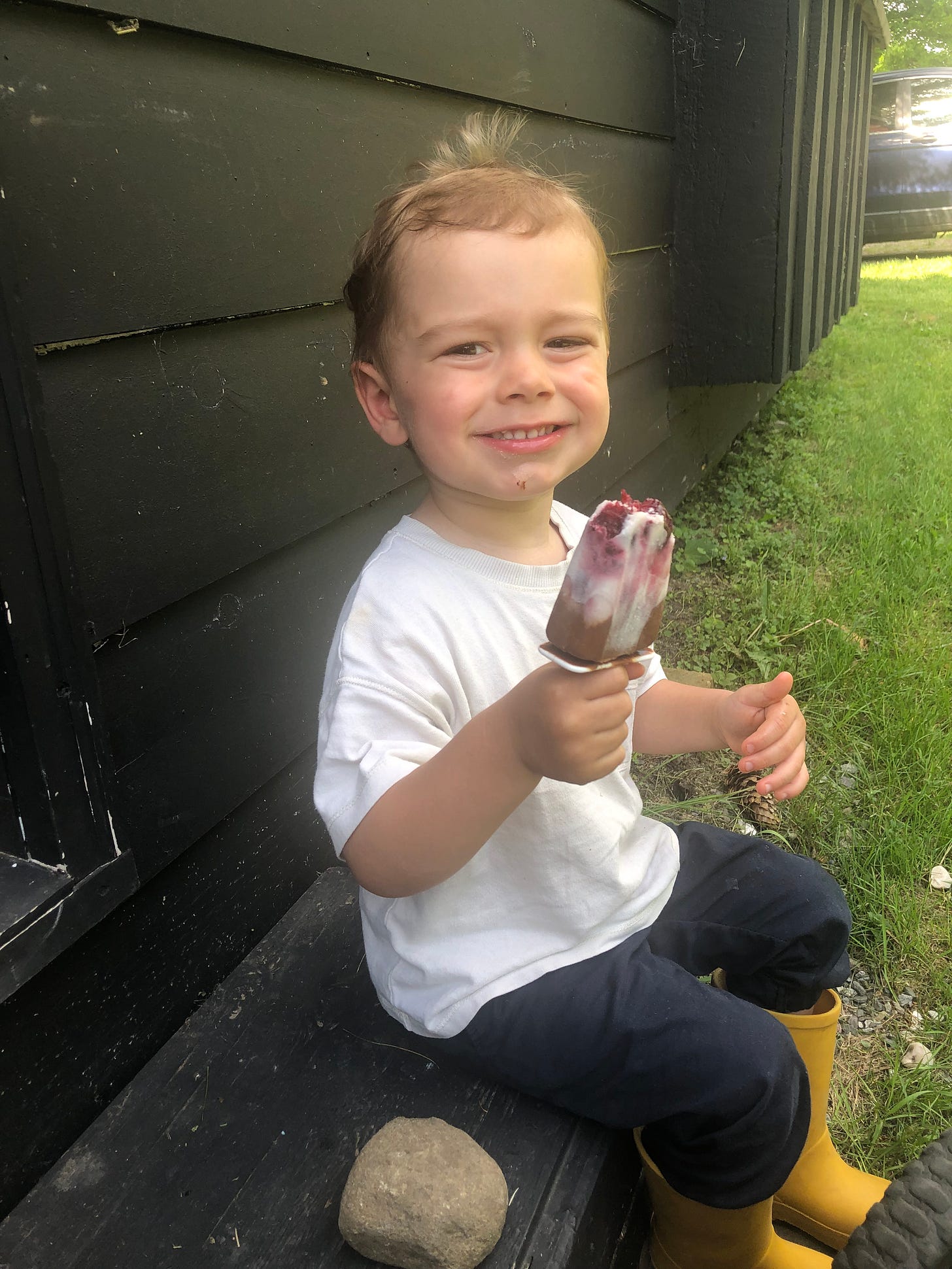I was seven years old when I got into my first car accident. My mom was driving me to school. I remember its abrupt impact, the suddenness of my view changing from straight to spinning; of moving through an intersection one moment to the uncertainty of being upside down. I don’t think we actually flipped over, but I do recall questioning my reality as it was changing before my eyes. What I remember most about this accident is the Slim Fast chocolate shake that flew up out of its cupholder and splattered itself all over our clothes, our dashboard and windshield. My mom told me afterwards that she thought the spilt shake was my blood. That was why she was screaming, she explained.
My mom and I were sharing that shake for breakfast on the way to school. This was before she joined Weight Watchers. Diet culture was a huge part of my upbringing, as it was a large part of my mother’s mid-twenties, raising me in the culture of Los Angeles as a single parent. I remember when she dated her personal trainer at the gym. His name was Oscar and he had huge lips. There was always money left on the kitchen counter for me to get myself fast food for dinner when my mom was working out. So I would take the money, walk to Carl’s Jr., order the Barbecue Western Cheeseburger combo to go and eat it while standing in front of the gym’s big window lined with adults my mom’s age running on the treadmills, hoping to catch sight of her.
I was raised primarily on fast food. Being in the car with my mom was where we spent a lot of our time together. Commuting, running away, and hitting the drive-thru. Every December, when my Aunt (13 years older) and Uncle (10 years older) would ask me what I wanted for Christmas, I would ask for the 5 for $5 special at Arby’s. Yes, I know. Disgusting. Artificial roast beef sandwiches. In hindsight, I think this request was a combination of not wanting to be a burden (being the only child around, I always got spoiled with “things” that I never wanted and thereby didn’t appreciate and thereby felt guilty about for wasting people’s money) and the desire for quality time, to be taken out to eat, to not have to eat dinner alone.
For whatever reason, food and quality time have always felt intrinsically linked to me, the child who never grew up sitting around a dinner table with her family every night.
*
Do you ever think about how gross it is that we’ve normalized the phrase “binge-watch”? As if to acknowledge, maybe only subconsciously, that our overconsumption is paralyzing, but we accept it as a “natural” part of our daily rhythms? There is nothing natural about the word binge.
The night of my high school prom, my other aunt (on my grandfather’s side, 6 years older) came over to do my makeup. I was living alone at the time and while I hated wearing makeup, I was hungry to be around family, to have people surrounding me that could recognize the significance of this time in my life.
She had asked me what took me so long to answer the door and what I didn’t tell her was that I was throwing up the Tostada Salad I had just binged from El Pollo Loco. Then I led her into that same bathroom and my shame evaporated into her affections.
My mom had left that year. I’m not ready to write about why, or where she went. Her drug addicted husband left with my baby sister and many of my valuable belongings that he would pawn for cash. I have no idea when the bulimia started, but it makes so much sense that I, still a child who had just barely learned how to drive, was seeking some sense of control over the world crumbling around her.
—
This morning I woke up, rolled over in bed and turned my attention to Google to trace down the origin of the phrase “cold turkey”. The expression, used to signify our immediate shift in habits, the idea of quitting something without outside intervention, first appeared in a 1920s newspaper, according to Reader’s Digest. The suspected origin of logic that seems to make the most sense to me is, to serve leftover turkey, cold turkey, is instantaneous.
My eating disorder stopped cold turkey when I went to college and moved into a house with four other roommates. The need to control inevitable chaos is still an urge I face with regularity, something I can’t quit as easily.
Hi, my name is Ashley and I’m a meal planner.
*
This month has me thinking about food because there is a change of season upon us. The snow in the Catskills is very slowly melting, washing away with the rain and offering us a thick mud that sticks to the bottoms of our boots while the birdsong scores our trips of re-stacking the firewood on the porch. Spring is finally here.
Yesterday while talking on the phone with my grandmother, I told her that we were having meatball subs for dinner and that I was going to miss meatball season.
“Why can’t you eat meatballs anymore?” she asked.
“It’s not that I can’t,” I explain. “I guess I view meatballs as a comfort food. They’re warm and hearty and perfect for a cold winter day. Sort of like soup.”
“Now soup is something you don’t want to eat in summer. But I think meatballs are a year round food.”
My grandma lives in California where there is no such thing as a season.
—
I’m breastfeeding my youngest son less and less with each passing week, another season creeping its way in. This sacred time of bonding, around food and nourishment, is quickly approaching its end and I’m equal parts ready, and not. When I was pregnant with my first child, my plan was to formula feed. I was formula fed as an infant, what was the harm? During my first pregnancy, the thought of having to continue sharing my body was the most unattractive idea in the world. I was yearning for physical space as I awaited my first baby’s arrival.
Now, my first is in PreK every day and having that physical space from one child has helped me to cherish the shift of attachment happening with the other. My second son and I read Where The Wild Things Are before nap instead of nursing. Rocking in the wicker chair as he turns the pages, Max, the king of all Wild Things, becomes lonely and wants to be where someone loves him most of all…
“Then from far away across the world, he smelled good things to eat, so he gave up being king of the Wild Things.”
—
On a recent FaceTime call with my mom, I was prepping dinner and I shared with her that I had finally lost all of my baby weight. I said this with pride having dedicated every ounce of free time to exercising, the endorphins serving as a savior on my darkest postpartum days. And I remember my mom cementing in my brain during pregnancy that her body went downhill after she had my sister. That the second kid would make it impossible to physically return to myself again.
What had I done to lose the weight, she asked, like there was a secret formula, a set of rules I followed. Nothing, I told her, I eat at home and I exercise almost every day. It was never a conscious goal of mine, but I grew curious around what that number on the scale would tell me because I was beginning to feel really good in my body again.
My mom currently lives on a diet of chicken, potatoes, corn and some occasional cheese. Oh, and oatmeal. This is her attempt at dealing with a handful of physical diagnoses— auto-immune disease, POTS, mast cell disorder— and while I don’t doubt the discomfort and inconvenience that these illnesses have brought to her life, I believe the paralyzation she experiences is bigger than the restrictive diet at hand. She will chew the foods she misses eating and spit them out without swallowing, believing these things don’t enter her system. That’s basically what anorexic people do, I tell her. She laughs and says “Really?” Eating her meat frozen, not fresh; nothing out of a can, but some takeout restaurants are okay; no gluten, no high-histamine fruits, I can’t keep track of all her rules…
This is the most consistent voice of my life. The one that seeks refuge in the diets, the shakes, the weight loss programs, and now illnesses. It’s a voice that lives in a state of constant deprivation. It uses food as a means of self-control. According to author John Allen of The Omnivorous Mind, “we eat with our minds as much as our stomachs,” and “when you see food you love, it releases dopamine in the brain, just like when you see a person that you love.”
*
When my best friend Stephie and I were pregnant last year, we talked on the phone one night about the differences in our pregnancy experiences the second time around, the fears and struggles we were having. I remember giving immense gratitude for my new Peloton bike and Stephie made this profound comment I can’t seem to forget. Something along the lines of: It makes so much sense that you would make this type of investment in yourself right now. You lost all control over your body during Jonah’s birth. The expression of daily exercise is giving you a sense of control you can’t get from anywhere else.
—
Over Christmas break I stumbled upon Michael Pollan’s Netflix series Cooked and after watching the first episode I was convinced I had discovered the Mother Theresa of food and agriculture. How had I not heard of this saint before??? I researched him, naturally. His Masterclass ads flooded my instagram feed, naturally. I purchased all his books and told my husband to gift wrap them for my stocking…
Then I binged the entire series that afternoon, and called my mom.
Naturally.
Below, my most frequented cookbooks and some food-related reads:
Half Baked Harvest Super Simple by Tiegan Gerard
I know, I know. I can’t even follow her on Instagram anymore because she’s blown up. But when I turned 30, one of my goals for the coming decade was to start a cookbook collection and I have to give credit where credit is due.
Being the recipient of a meal train after having a kid in the city was a huge gift, no doubt, but we quickly grew sick of the wide array of takeout food available to us. Until one friend made a home cooked meal from this blog. I followed suit and tried a recipe from HBH as soon as I was back on my own two feet, bought this book right after, and basically cooked everything in it (except the sweets, I’m more of a savory gal.) I don’t turn to it as often anymore, but this book holds a story of heavy significance on my kitchen shelf. The main meal I return to by memory is her Everything Bagel Salad with White Beans and Pesto p.80.
Simply Julia by Julia Turshen
What I love about my fellow upstate NY dweller Julia Turshen is — well, so much actually — her flexibility. Every recipe offers room to switch it up according to your liking. She also has a newsletter that offers the most practical tips for cooking, hosting, etc and I really love that. Because cooking is supposed to be an expression of creativity and I think Turshen brings that out in a really efficient and logical way. Some of my regular go-tos from this book include: Green Chile Braised Chicken Thighs with Pinto Beans p.85, Sticky Chicken p.82, and Black Bean and Corn Tamale Pie p.53.
The Modern Proper: Simple Dinners for Everyday by Holly Erickson and Natalie Mortimer
This is currently one of my most active references in the kitchen. This book is the reason I fell in love with making meatballs this winter. It has an entire chapter dedicated to meatballs. Paprika Chicken Meatballs in Tomato Sauce with Lemon Dill Cream p.216, Spiced Lamb Meatballs with Cilantro Yogurt p.224… Meatballs aside, we’ve picked up a handful of staple recipes from this book that we always keep in the mix of our weekly mean plans, like their Creamy Tortellini Soup with Sausage and Kale p.255, Pickled Onions p.268, and Crispy Carnitas p.161. I found these gals on Instagram so I guess I owe thanks to the annoyingly spot on algorithm.
Feeding A Family: Simple and Healthy Weeknight Meals the Whole Family Will Love by Sarah Waldman
Not the first time I’m mentioning this cookbook on here. It is my most worn and weathered book and has maintained its place on my kitchen counter for about two years now, at least. Simple and healthy is a damn near perfect description. Minimal ingredients. Crowd pleasers. No-fuss. Kid-friendly. And seasonal! Some of these recipes feel so special to me now, marking the change of a season, like her Splayed Roast Chicken with Spring Vegetables p.144 which I made for Easter last year and it made the smoke alarm go off and my toddler has talked about that memory on a weekly basis every since. The chicken turned out perfect. Waldman gives tips on how to serve to babies and gives great recommendations on how to repurpose your leftovers.
As a person who does not favor sweet treats, this book holds some of my absolute favorite desserts: The Quick Citrus-Dark Chocolate Cake p.56 which I made for Silas’s first birthday party and accidentally bought grapefruits instead of blood oranges, Blender Chocolate Mousse with Raspberries p.185, Coconut Chocolate Cherry Pops p.165 and Chocolate-Mint Milkshakes p.141.
When hosting a gathering I always turn to the Slow Cooker Greek Chicken Gyros p.204 or Classic Carolina Pulled Pork Sandwiches p.188, and Sweet and Sour Potato Salad p.171 is the perfect accompaniment to any 4th of July party.
Melissa Clark and Sam Sifton
These are two names you probably recognize if you subscribe to New York Times Cooking. If you do not, I can’t recommend them enough. Melissa Clark is fabulous — she’s written so many cookbooks— and her latest is all about the efficient approach: one pot, one sheet, etc, which I love.
Sam Sifton is my favorite recipe writer ever, though he tends to drive a lot of people crazy. If cooking doesn’t feel like a naturally creative expression for you, if you find yourself needing to abide by a recipe strictly because you don’t want to mess it up, Sifton probably isn’t going to jive. His instructions are less a precise measurement and more of “a pinch,” “a dash”, etc. It’s suggestive, which I find extremely accommodating. He has changed the way I make fish tacos and I’m forever grateful.
…
Lessons in Chemistry by Bonnie Garmus
This has been my favorite read so far this year. Elizabeth Zott is a female chemist in the late ‘50s/early ‘60s and she has a hard time being taken seriously, especially when she finds herself hosting a cooking show called Supper at Six. Her character is empowering, quirky and charming and unfortunately the issues she faces in this fictional plot are still frustratingly common “women’s troubles” of today. This is a debut novel and I’m eager to interview Garmus about the book with all its lovely characters and subplots, but I’m still thinking about my angle. Anything you want to know? Message me!
If you want one of those easy “summer read” fiction novels, don’t be intimidated by its size— this is a page turner.
My First Popsicle: An Anthology of Food and Feelings edited by Zosia Mamet
I don’t understand why anthologies don’t get better press. I recently interviewed for a PR position at a small publisher and that was one of my favorite questions they asked me. What book(s) did I think got too much hype and/or which one(s) didn’t get enough? After some thought my answer was anthologies. Here you have a compilation of so many great writers — Sloane Crosley, Stephanie Danler, Patti Smith, Jia Tolentino — all discussing a moment of sentiment intrinsically linked to food. And with essays like this, you don’t need to follow a single story line for very long. You can jump in and jump out when the moment strikes you. They’re my favorite books to keep stocked on my home library shelves; my favorite reads to keep in a bag for those in-between moments, like pumping in the bathroom at my co-working space, riding the subway, etc. What a beautiful, valuable, delectable bite of good writing.
Everything by Michael Pollan
I need to end my recs with Pollan, don’t I? It seems narratively satisfying. I’ll be reading Second Nature: A Gardener’s Education this Spring while I prepare my garden, and I couldn’t be more excited. His approach to food is wicked good, pure genius, and gets me so excited to make as many things from scratch as possible without becoming Amish or Mennonite.
That’s all for now! Happy reading, happy eating.
Happy Spring, my friends. <3









❤️❤️❤️